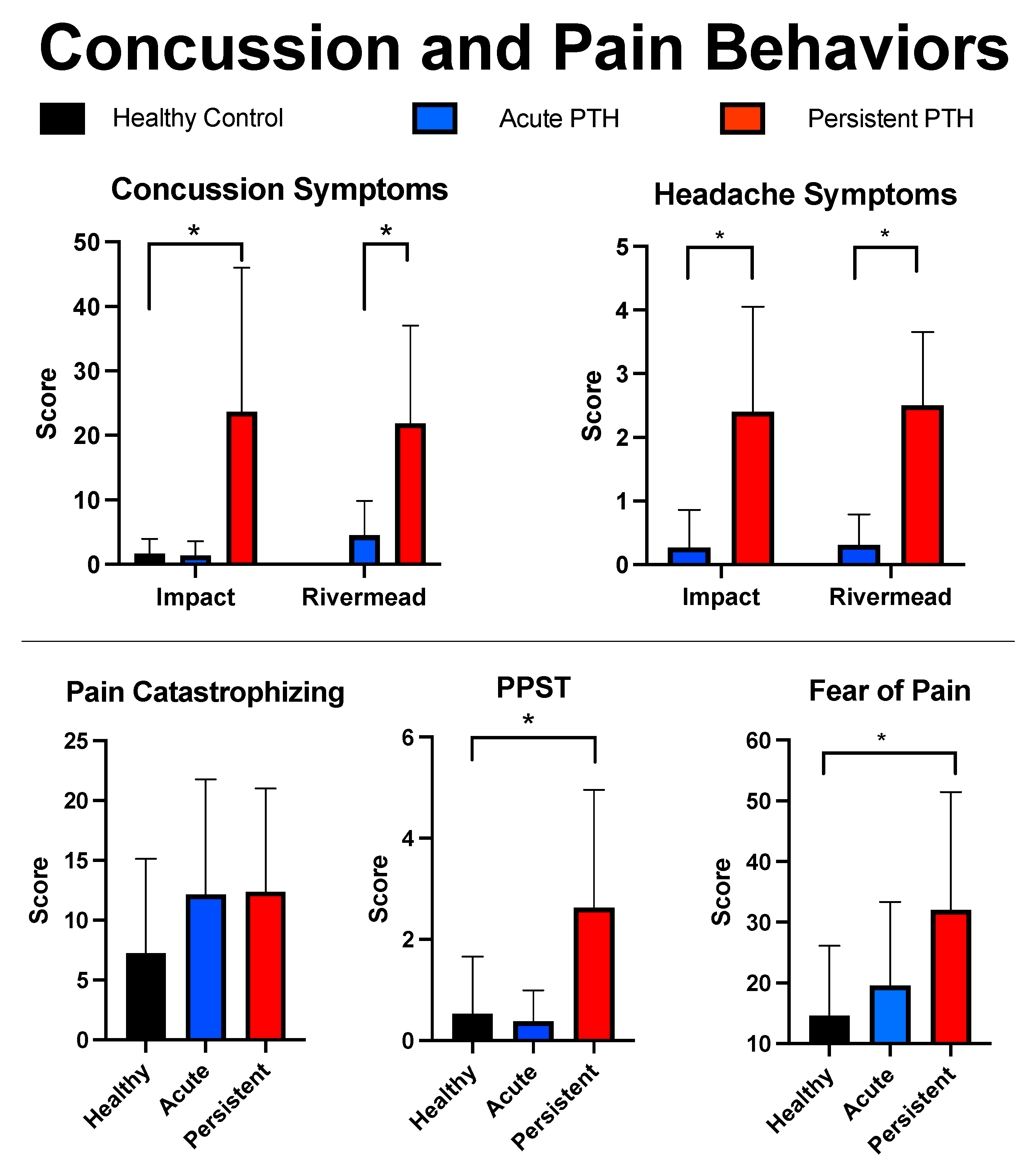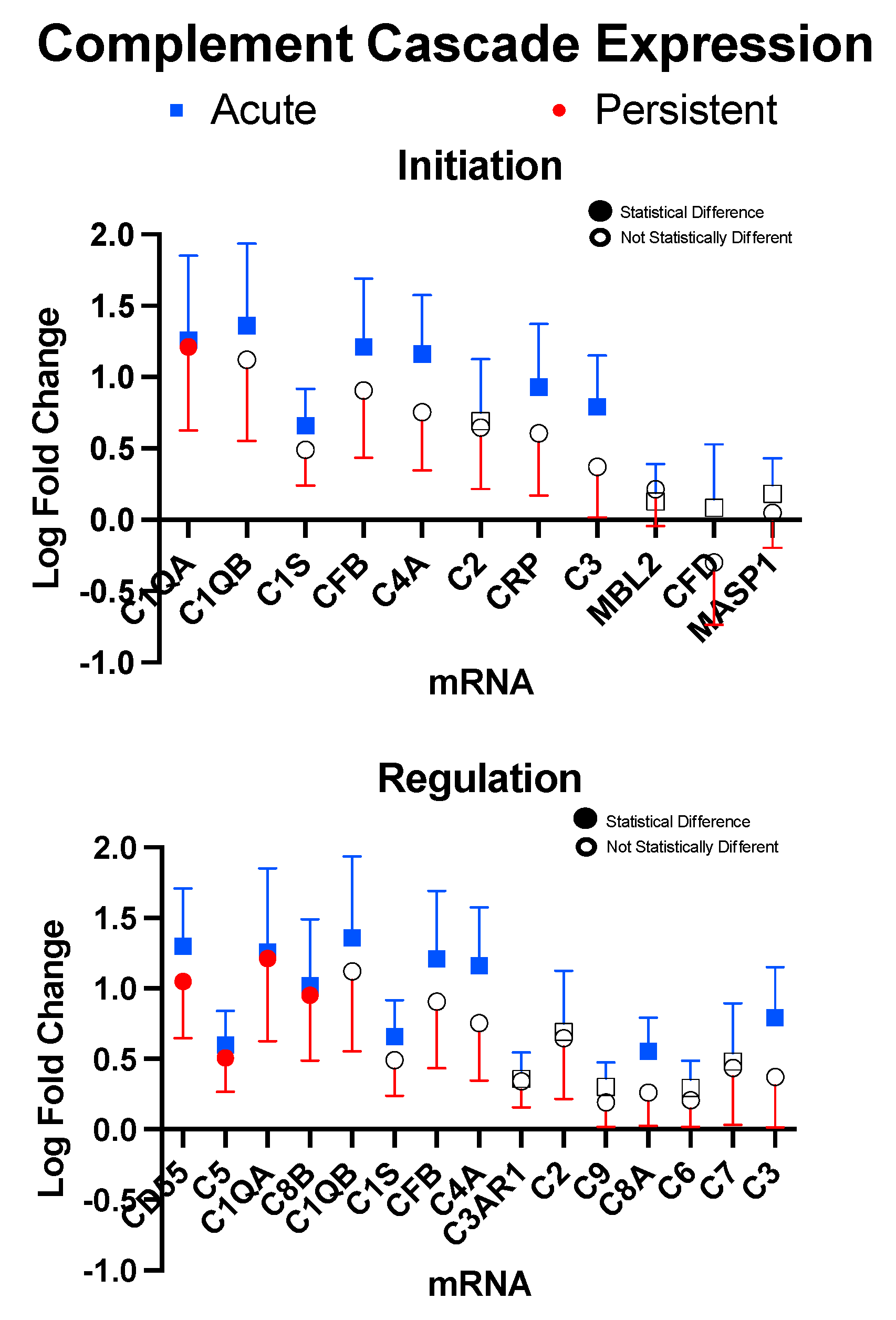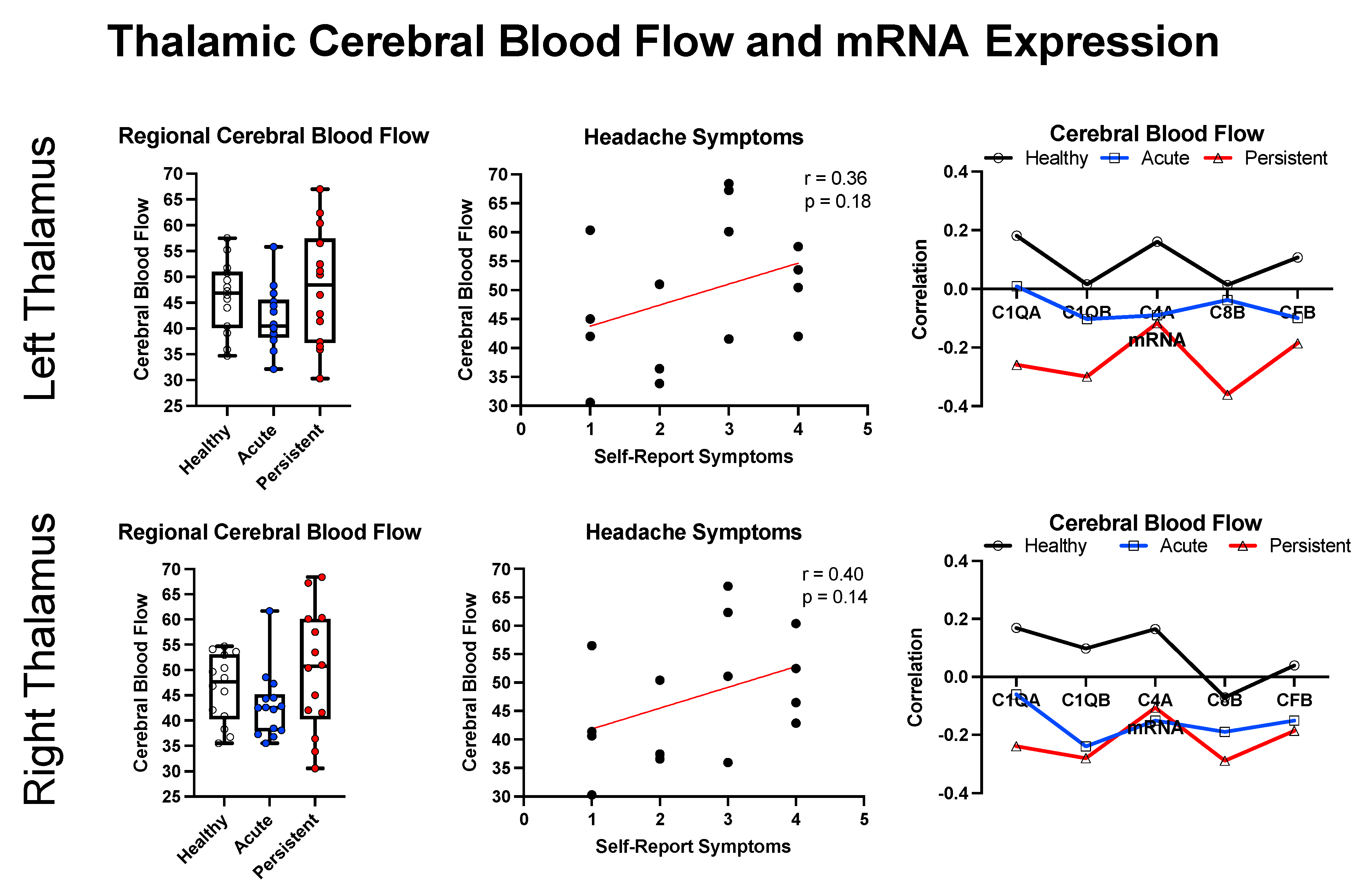Evidence of Chronic Complement Activation in Asymptomatic Pediatric Brain Injury Patients: A Pilot Study
Abstract
1. Introduction
2. Methods
2.1. Psychological Questionnaires and Testing
2.2. Magnetic Resonance Imaging Data Acquisition
2.3. ASL Data Processing
2.4. Diffusion MRI
2.5. Transcriptome Profiling on Saliva Samples
2.6. Nanostring Gene Expression Analysis
2.7. Statistical Analysis
3. Results
3.1. Participant Demographics
3.2. Neuroimaging
3.3. Complement Cascade: Pathway Analysis
3.4. Complemented Mediated Activity Driven by Core Set of mRNA
4. Discussion
4.1. Elevated Complement Activity in Pediatric Subjects with PTH
4.2. Dissociating PTH Cohorts and the Role of Symptom Presentation
4.3. The Role of Complement in Brain Injury and PTH Symptom Persistence
Author Contributions
Funding
Institutional Review Board Statement
Informed Consent Statement
Data Availability Statement
Conflicts of Interest
References
- Popescu, C.; Anghelescu, A.; Daia, C.; Onose, G. Actual data on epidemiological evolution and prevention endeavours regarding traumatic brain injury. J. Med. Life 2015, 8, 272–277. [Google Scholar] [PubMed]
- Faux, S.; Sheedy, J. A Prospective Controlled Study in the Prevalence of Posttraumatic Headache Following Mild Traumatic Brain Injury. Pain Med. 2008, 9, 1001–1011. [Google Scholar] [CrossRef] [PubMed]
- Schwedt, T.J. Structural and Functional Brain Alterations in Post-traumatic Headache Attributed to Mild Traumatic Brain Injury: A Narrative Review. Front. Neurol. 2019, 10, 615. [Google Scholar] [CrossRef] [PubMed]
- Rau, J.C.; Dumkrieger, G.M.; Chong, C.D.; Schwedt, T.J. Imaging Post-Traumatic Headache. Curr. Pain Headache Rep. 2018, 22, 64. [Google Scholar] [CrossRef] [PubMed]
- Burrowes, S.A.B.; Rhodes, C.S.; Meeker, T.J.; Greenspan, J.D.; Gullapalli, R.P.; Seminowicz, D.A. Decreased grey matter volume in mTBI patients with post-traumatic headache compared to headache-free mTBI patients and healthy controls: A longitudinal MRI study. Brain Imaging Behav. 2020, 14, 1651–1659. [Google Scholar] [CrossRef]
- Chong, C.D.; Berisha, V.; Ross, K.; Kahn, M.; Dumkrieger, G.; Schwedt, T.J. Distinguishing persistent post-traumatic headache from migraine: Classification based on clinical symptoms and brain structural MRI data. Cephalalgia 2021, 41, 943–955. [Google Scholar] [CrossRef]
- Younis, S.; Hougaard, A.; Noseda, R.; Ashina, M. Current understanding of thalamic structure and function in migraine. Cephalalgia 2019, 39, 1675–1682. [Google Scholar] [CrossRef]
- Perry, C.J.; Blake, P.; Buettner, C.; Papavassiliou, E.; Schain, A.J.; Bhasin, M.K.; Burstein, R. Upregulation of inflammatory gene transcripts in periosteum of chronic migraineurs: Implications for extracranial origin of headache: Inflamed Periosteum in CM. Ann. Neurol. 2016, 79, 1000–1013. [Google Scholar] [CrossRef]
- Kossmann, T.; Stahel, P.F.; Morganti-Kossmann, M.C.; Jones, J.L.; Barnum, S.R. Elevated levels of the complement components C3 and factor B in ventricular cerebrospinal fluid of patients with traumatic brain injury. J. Neuroimmunol. 1997, 73, 63–69. [Google Scholar] [CrossRef]
- Stahel, P.F.; Morganti-Kossmann, M.C.; Perez, D.; Redaelli, C.; Gloor, B.; Trentz, O.; Kossmann, T. Intrathecal levels of complement-derived soluble membrane attack complex (sC5b-9) correlate with blood-brain barrier dyfunction in patients with traumativ brain injury. J. Neurotrauma 2001, 18, 773–781. [Google Scholar] [CrossRef]
- Stahel, P.F.; Morganti-Kossmann, M.C.; Kossmann, T. The role of the complement system in traumatic brain injury. Brain Res. Rev. 1998, 27, 243–256. [Google Scholar] [CrossRef] [PubMed]
- Osthoff, M.; Walder, B.; Delhumeau, C.; Trendelenburg, M.; Turck, N. Association of Lectin Pathway Protein Levels and Genetic Variants Early after Injury with Outcomes after Severe Traumatic Brain Injury: A Prospective Cohort Study. J. Neurotrauma 2017, 34, 2560–2566. [Google Scholar] [CrossRef] [PubMed]
- Dinet, V.; Petry, K.G.; Badaut, J. Brain–Immune Interactions and Neuroinflammation After Traumatic Brain Injury. Front. Neurosci. 2019, 13, 1178. [Google Scholar] [CrossRef] [PubMed]
- Fraser, D.A.; Pisalyaput, K.; Tenner, A.J. C1q enhances microglial clearance of apoptotic neurons and neuronal blebs, and modulates subsequent inflammatory cytokine production. J. Neurochem. 2010, 112, 733–743. [Google Scholar] [CrossRef] [PubMed]
- Fraser, D.A.; Laust, A.K.; Nelson, E.; Tenner, A.J. C1q Differentially Modulates Phagocytosis and Cytokine Responses during Ingestion of Apoptotic Cells by Human Monocytes, Macrophages, and Dendritic Cells. J. Immunol. 2009, 183, 6175–6185. [Google Scholar] [CrossRef]
- Markiewski, M.; Daugherity, E.; Reese, B.; Karbowniczek, M. The Role of Complement in Angiogenesis. Antibodies 2020, 9, 67. [Google Scholar] [CrossRef]
- Ricklin, D.; Hajishengallis, G.; Yang, K.; Lambris, J.D. Complement: A key system for immune surveillance and homeostasis. Nat. Immunol. 2010, 11, 785–797. [Google Scholar] [CrossRef]
- Longhi, L.; Perego, C.; Ortolano, F.; Zanier, E.R.; Bianchi, P.; Stocchetti, N.; McIntosh, T.; De Simoni, M.G. C1-inhibitor attenuates neurobehavioral deficits and reduces contusion volume after controlled cortical impact brain injury in mice. Crit. Care Med. 2009, 37, 659–665. [Google Scholar] [CrossRef]
- Rich, M.C.; Keene, C.N.; Neher, M.D.; Johnson, K.; Yu, Z.-X.; Ganivet, A.; Holers, V.M.; Stahel, P.F. Site-targeted complement inhibition by a complement receptor 2-conjugated inhibitor (mTT30) ameliorates post-injury neuropathology in mouse brains. Neurosci. Lett. 2016, 617, 188–194. [Google Scholar] [CrossRef]
- Alawieh, A.; Langley, E.F.; Weber, S.; Adkins, D.; Tomlinson, S. Identifying the Role of Complement in Triggering Neuroinflammation after Traumatic Brain Injury. J. Neurosci. 2018, 38, 2519–2532. [Google Scholar] [CrossRef]
- Leinhase, I.; Rozanski, M.; Harhausen, D.; Thurman, J.M.; Schmidt, O.I.; Hossini, A.M.; Taha, M.E.; Rittirsch, D.; Ward, P.A.; Holers, V.M.; et al. Inhibition of the alternative complement activation pathway in traumatic brain injury by a monoclonal anti-factor B antibody: A randomized placebo-controlled study in mice. J. Neuroinflammation 2007, 4, 13. [Google Scholar] [CrossRef] [PubMed]
- McEvoy, H.; Borsook, D.; Holmes, S.A. Clinical features and sex differences in pediatric post-traumatic headache: A retrospective chart review at a Boston area concussion clinic. Cephalalgia 2020, 40, 701–711. [Google Scholar] [CrossRef] [PubMed]
- Kovacs, M. The Children’s Depression, Inventory (CDI). Psychopharmacol. Bull. 1985, 21, 995–998. Available online: https://pubmed.ncbi.nlm.nih.gov/4089116/ (accessed on 19 December 2022). [PubMed]
- Beck, A.T.; Steer, R.A.; Brown, G.K. Manual for the Beck Depression Inventory-II. 1996. Available online: https://www.scienceopen.com/document?vid=9feb932d-1f91-4ff9-9d27-da3bda716129 (accessed on 19 December 2022).
- Reynolds, C.R.; Richmond, B.O. Revised Children’s Manifest Anxiety Scales (RCMAS). Available online: https://www.pathwaysstudy.pitt.edu/codebook/rcmas-sb.html (accessed on 19 December 2022).
- Petersen, A.C.; Crockett, L.; Richards, M.; Boxer, A. A self-report measure of pubertal status: Reliability, validity, and initial norms. J. Youth Adolesc. 1988, 17, 117–133. [Google Scholar] [CrossRef]
- Sullivan, M.J.L.; Bishop, S.R.; Pivik, J. The Pain Catastrophizing Scale: Development and Validation. Psychol. Assess. 1995, 7, 524. [Google Scholar] [CrossRef]
- McNeil, D.W.; Rainwater, A.J. Development of the Fear of Pain Questionnaire-III. J. Behav. Med. 1998, 21, 389–410. [Google Scholar] [CrossRef]
- Simons, L.E.; Smith, A.; Ibagon, C.; Coakley, R.; Logan, D.E.; Schechter, N.; Borsook, D.; Hill, J.C. Pediatric Pain Screening Tool: Rapid identification of risk in youth with pain complaints. Pain 2015, 156, 1511–1518. [Google Scholar] [CrossRef]
- Crawford, S.; Wade, D. The rivermead head injur follow up questionnaire: A study of a new rating scale and other measures to evaluate outcome after head injury. J. Neurol. Neurosurg. Psychiatry 1996, 60, 510–514. [Google Scholar] [CrossRef]
- Morin, A.; Eisenbraun, B.; Key, J.; Sanschagrin, P.C.; Timony, M.A.; Ottaviano, M.; Sliz, P. Collaboration gets the most out of software. eLife 2013, 2, e01456. [Google Scholar] [CrossRef]
- Tournier, J.-D.; Smith, R.; Raffelt, D.; Tabbara, R.; Dhollander, T.; Pietsch, M.; Christiaens, D.; Jeurissen, B.; Yeh, C.-H.; Connelly, A. MRtrix3: A fast, flexible and open software framework for medical image processing and visualisation. Neuroimage 2019, 202, 116137. [Google Scholar] [CrossRef]
- Cordero-Grande, L.; Christiaens, D.; Hutter, J.; Price, A.N.; Hajnal, J.V. Complex diffusion-weighted image estimation via matrix recovery under general noise models. Neuroimage 2019, 200, 391–404. [Google Scholar] [CrossRef] [PubMed]
- Veraart, J.; Fieremans, E.; Novikov, D.S. Diffusion MRI noise mapping using random matrix theory: Diffusion MRI Noise Mapping. Magn. Reson. Med. 2016, 76, 1582–1593. [Google Scholar] [CrossRef] [PubMed]
- Veraart, J.; Novikov, D.S.; Christiaens, D.; Ades-Aron, B.; Sijbers, J.; Fieremans, E. Denoising of diffusion MRI using random matrix theory. Neuroimage 2016, 142, 394–406. [Google Scholar] [CrossRef] [PubMed]
- Kellner, E.; Dhital, B.; Kiselev, V.G.; Reisert, M. Gibbs-ringing artifact removal based on local subvoxel-shifts: Gibbs-Ringing Artifact Removal. Magn. Reson. Med. 2016, 76, 1574–1581. [Google Scholar] [CrossRef]
- Andersson, J.L.R.; Sotiropoulos, S.N. An integrated approach to correction for off-resonance effects and subject movement in diffusion MR imaging. NeuroImage 2016, 125, 1063–1078. [Google Scholar] [CrossRef] [PubMed]
- Andersson, J.L.; Skare, S.; Ashburner, J. How to correct susceptibility distortions in spin-echo echo-planar images: Application to diffusion tensor imaging. Neuroimage 2003, 20, 870–888. [Google Scholar] [CrossRef]
- Smith, S.M.; Jenkinson, M.; Woolrich, M.W.; Beckmann, C.F.; Behrens, T.E.; Johansen-Berg, H.; Bannister, P.R.; De Luca, M.; Drobnjak, I.; Flitney, D.E.; et al. Advances in functional and structural MR image analysis and implementation as FSL. Neuroimage 2004, 23, S208–S219. [Google Scholar] [CrossRef]
- Wasserthal, J.; Neher, P.; Maier-Hein, K.H. TractSeg—Fast and accurate white matter tract segmentation. Neuroimage 2018, 183, 239–253. [Google Scholar] [CrossRef]
- Sours, C.; George, E.O.; Zhuo, J.; Roys, S.; Gullapalli, R.P. Hyper-connectivity of the thalamus during early stages following mild traumatic brain injury. Brain Imaging Behav. 2015, 9, 550–563. [Google Scholar] [CrossRef]
- Holden, S.S.; Grandi, F.C.; Aboubakr, O.; Higashikubo, B.; Cho, F.S.; Chang, A.H.; Forero, A.O.; Morningstar, A.R.; Mathur, V.; Kuhn, L.J.; et al. Complement factor C1q mediates sleep spindle loss and epileptic spikes after mild brain injury. Science 2021, 373, eabj2685. [Google Scholar] [CrossRef]
- Holmes, S.A.; Singh-Saluja, R.; Chen, J.-K.; Gagnon, I.; Ptito, A. Evaluating task-based brain network activity in pediatric subjects with an mTBI: Mechanisms of functional compensation are symptom-level dependent. Brain Inj. 2019, 33, 383–393. [Google Scholar] [CrossRef] [PubMed]
- Lemme, J.; Holmes, S.; Sibai, D.; Mar’I, J.; Simons, L.E.; Burstein, R.; Zurakowski, D.; Lebel, A.; O’Brien, M.; Upadhyay, J.; et al. Altered Brain Network Connectivity Underlies Persistent Post-Traumatic Headache following Mild Traumatic Brain Injury in Youth. J. Neurotrauma 2021, 38, 1632–1641. [Google Scholar] [CrossRef] [PubMed]
- Chaban, V.; Clarke, G.J.; Skandsen, T.; Islam, R.; Einarsen, C.E.; Vik, A.; Damås, J.K.; Mollnes, T.E.; Håberg, A.K.; Pischke, S.E. Systemic Inflammation Persists the First Year after Mild Traumatic Brain Injury: Results from the Prospective Trondheim Mild Traumatic Brain Injury Study. J. Neurotrauma 2020, 37, 2120–2130. [Google Scholar] [CrossRef] [PubMed]
- Reis, E.S.; Mastellos, D.; Hajishengallis, G.; Lambris, J.D. New insights into the immune functions of complement. Nat. Rev. Immunol. 2019, 19, 503–516. [Google Scholar] [CrossRef]
- Hammad, A.; Westacott, L.; Zaben, M. The role of the complement system in traumatic brain injury: A review. J. Neuroinflammation 2018, 15, 24. [Google Scholar] [CrossRef] [PubMed]
- Mallah, K.; Couch, C.; Alshareef, M.; Borucki, D.; Yang, X.; Alawieh, A.; Tomlinson, S. Complement mediates neuroinflammation and cognitive decline at extended chronic time points after traumatic brain injury. Acta Neuropathol. Commun. 2021, 9, 72. [Google Scholar] [CrossRef] [PubMed]
- Rupprecht, R.; Rupprecht, C.; Di Benedetto, B.; Rammes, G. Neuroinflammation and psychiatric disorders: Relevance of C1q, translocator protein (18 kDa) (TSPO), and neurosteroids. World J. Biol. Psychiatry 2021, 23, 257–263. [Google Scholar] [CrossRef] [PubMed]
- Gomez-Arboledas, A.; Acharya, M.M.; Tenner, A.J. The Role of Complement in Synaptic Pruning and Neurodegeneration. ImmunoTargets Ther. 2021, 10, 373–386. [Google Scholar] [CrossRef]
- Chen, L.-H.; Liu, J.-F.; Lu, Y.; He, X.-Y.; Zhang, C.; Zhou, H.-H. Complement C1q (C1qA, C1qB, and C1qC) May Be a Potential Prognostic Factor and an Index of Tumor Microenvironment Remodeling in Osteosarcoma. Front. Oncol. 2021, 11, 642144. [Google Scholar] [CrossRef]
- Ornstein, B.W.; Atkinson, J.P.; Densen, P. The complement system in pediatric systemic lupus erythematosus, atypical hemolytic uremic syndrome, and complocentric membranoglomerulopathies. Curr. Opin. Rheumatol. 2012, 24, 522–529. [Google Scholar] [CrossRef]
- Bayly-Jones, C.; Bubeck, D.; Dunstone, M.A. The mystery behind membrane insertion: A review of the complement membrane attack complex. Philos. Trans. R. Soc. B: Biol. Sci. 2017, 372, 20160221. [Google Scholar] [CrossRef] [PubMed]
- Föcking, M.; Sabherwal, S.; Cates, H.M.; Scaife, C.; Dicker, P.; Hryniewiecka, M.; Wynne, K.; Rutten, B.P.F.; Lewis, G.; Cannon, M.; et al. Complement pathway changes at age 12 are associated with psychotic experiences at age 18 in a longitudinal population-based study: Evidence for a role of stress. Mol. Psychiatry 2021, 26, 524–533. [Google Scholar] [CrossRef]
- Woo, J.J.; Pouget, J.G.; Zai, C.C.; Kennedy, J.L. The complement system in schizophrenia: Where are we now and what’s next? Mol. Psychiatry 2020, 25, 114–130. [Google Scholar] [CrossRef] [PubMed]
- Maes, M.; Carvalho, A.F. The Compensatory Immune-Regulatory Reflex System (CIRS) in Depression and Bipolar Disorder. Mol. Neurobiol. 2018, 55, 8885–8903. [Google Scholar] [CrossRef]
- Wang, Y.; Wang, Y.; Yang, Q.; Guo, L.; Yin, Y.; Fan, N.; Xiaomin, Z.; Su-Ping, C.; Kaufman, P.L.; Xuyang, L. Neuroprotective effects of C3 exoenzyme in excitotoxic retinopathy. Exp. Eye Res. 2014, 125, 128–134. [Google Scholar] [CrossRef] [PubMed][Green Version]
- Guo, R.-F.; Ward, P.A. ROLE OF C5A IN INFLAMMATORY RESPONSES. Annu. Rev. Immunol. 2005, 23, 821–852. [Google Scholar] [CrossRef]
- Tohgi, H.; Utsugisawa, K.; Nagane, Y. Hypoxia-induced expression of C1q, a subcomponent of the complement system, in cultured rat PC12 Cells. Neurosci. Lett. 2000, 291, 151–154. [Google Scholar] [CrossRef]
- Lu, J.; Kishore, U. C1 Complex: An Adaptable Proteolytic Module for Complement and Non-Complement Functions. Front. Immunol. 2017, 8, 592. [Google Scholar] [CrossRef]
- Stokowska, A.; Atkins, A.L.; Morán, J.; Pekny, T.; Bulmer, L.; Pascoe, M.C.; Barnum, S.R.; Wetsel, R.A.; Nilsson, J.A.; Dragunow, M.; et al. Complement peptide C3a stimulates neural plasticity after experimental brain ischaemia. Brain 2017, 140, 353–369. [Google Scholar] [CrossRef]
- Sweigard, J.H.; Yanai, R.; Gaissert, P.; Saint-Geniez, M.; Kataoka, K.; Thanos, A.; Stahl, G.L.; Lambris, J.D.; Connor, K.M. The alternative complement pathway regulates pathological angiogenesis in the retina. FASEB J. 2014, 28, 3171–3182. [Google Scholar] [CrossRef]
- Johnson, P.T.; Brown, M.N.; Pulliam, B.C.; Anderson, N.H. Synaptic Pathology, Altered Gene Expression, and Degeneration in Photoreceptors Impacted by Drusen. Investig. Opthalmology Vis. Sci. 2005, 46, 4788–4795. [Google Scholar] [CrossRef] [PubMed]
- Hecker, L.A.; Edwards, A.O. Genetic Control of Complement Activation in Humans and Age Related Macular Degeneration. Inflamm. Retin. Dis. Complement Biol. Pathol. 2010, 703, 49–62. [Google Scholar] [CrossRef]
- Bellander, B.-M.; Singhrao, S.K.; Ohlsson, M.; Mattsson, P.; Svensson, M. Complement Activation in the Human Brain after Traumatic Head Injury. J. Neurotrauma 2001, 18, 1295–1311. [Google Scholar] [CrossRef] [PubMed]
- Longhi, L.; Orsini, F.; De Blasio, D.; Fumagalli, S.; Ortolano, F.; Locatelli, M.; Stocchetti, N.; De Simoni, M.-G. Mannose-Binding Lectin Is Expressed After Clinical and Experimental Traumatic Brain Injury and Its Deletion Is Protective. Crit. Care Med. 2014, 42, 1910–1918. [Google Scholar] [CrossRef]
- Bossi, F.; Tripodo, C.; Rizzi, L.; Bulla, R.; Agostinis, C.; Guarnotta, C.; Munaut, C.; Baldassarre, G.; Papa, G.; Zorzet, S.; et al. C1q as a unique player in angiogenesis with therapeutic implication in wound healing. Proc. Natl. Acad. Sci. USA 2014, 111, 4209–4214. [Google Scholar] [CrossRef]
- Ruan, C.-C.; Gao, P.-J. Role of Complement-Related Inflammation and Vascular Dysfunction in Hypertension. Hypertension 2019, 73, 965–971. [Google Scholar] [CrossRef]
- Wenzel, U.O.; Kemper, C.; Bode, M. The role of complement in arterial hypertension and hypertensive end organ damage. Br. J. Pharmacol. 2021, 178, 2849–2862. [Google Scholar] [CrossRef]
- Chen, L.; Fukuda, N.; Matsumoto, T.; Abe, M. Role of complement 3 in the pathogenesis of hypertension. Hypertens. Res. 2020, 43, 255–262. [Google Scholar] [CrossRef]
- Buurma, A.; Cohen, D.; Veraar, K.; Schonkeren, D.; Claas, F.H.; Bruijn, J.A.; Bloemenkamp, K.W.; Baelde, H.J. Preeclampsia Is Characterized by Placental Complement Dysregulation. Hypertension 2012, 60, 1332–1337. [Google Scholar] [CrossRef]
- Wang, H.; Ricklin, D.; Lambris, J.D. Complement-activation fragment C4a mediates effector functions by binding as untethered agonist to protease-activated receptors 1 and 4. Proc. Natl. Acad. Sci. USA 2017, 114, 10948–10953. [Google Scholar] [CrossRef]
- Györffy, B.A.; Kun, J.; Török, G.; Bulyáki, É.; Borhegyi, Z.; Gulyássy, P.; Kis, V.; Szocsics, P.; Micsonai, A.; Matkó, J.; et al. Local apoptotic-like mechanisms underlie complement-mediated synaptic pruning. Proc. Natl. Acad. Sci. USA 2018, 115, 6303–6308. [Google Scholar] [CrossRef] [PubMed]





| Healthy Control (n = 14) | Acute PTH (n = 15) | Persistent PTH (n = 15) | ||||
|---|---|---|---|---|---|---|
| M | SD | M | SD | M | SD | |
| Time Since Injury (days) | - | - | 105.625 | 12.03 | 101 | 12.36 |
| Age (years) | 16.47 | 2.48 | 16.2 | 2.52 | 15.4 | 2.17 |
| Females (#) | 8 | 50 | 9 | 56 | 11 | 69 |
| Rivermead Scale | - | - | 4.5 | 5.3 | 21.9 | 15.2 |
| Pain Catastrophizing Scale | 7.26 | 7.87 | 12.125 | 9.64 | 12.375 | 8.64 |
| Fear of Pain | 14.6 | 11.52 | 19.56 | 13.8 | 32 | 19.45 |
| Pediatric Pain Screening Tool | 0.53 | 1.125 | 0.375 | 0.62 | 2.625 | 2.33 |
| Impact Scale | - | - | 1.4 | 2.16 | 23.7 | 22.4 |
Disclaimer/Publisher’s Note: The statements, opinions and data contained in all publications are solely those of the individual author(s) and contributor(s) and not of MDPI and/or the editor(s). MDPI and/or the editor(s) disclaim responsibility for any injury to people or property resulting from any ideas, methods, instructions or products referred to in the content. |
© 2022 by the authors. Licensee MDPI, Basel, Switzerland. This article is an open access article distributed under the terms and conditions of the Creative Commons Attribution (CC BY) license (https://creativecommons.org/licenses/by/4.0/).
Share and Cite
Holmes, S.A.; Mar’i, J.; Lemme, J.; Maallo, A.M.; Lebel, A.; Simons, L.; O’Brien, M.J.; Zurakowski, D.; Burnstein, R.; Borsook, D. Evidence of Chronic Complement Activation in Asymptomatic Pediatric Brain Injury Patients: A Pilot Study. Children 2023, 10, 45. https://doi.org/10.3390/children10010045
Holmes SA, Mar’i J, Lemme J, Maallo AM, Lebel A, Simons L, O’Brien MJ, Zurakowski D, Burnstein R, Borsook D. Evidence of Chronic Complement Activation in Asymptomatic Pediatric Brain Injury Patients: A Pilot Study. Children. 2023; 10(1):45. https://doi.org/10.3390/children10010045
Chicago/Turabian StyleHolmes, Scott A., Joud Mar’i, Jordan Lemme, Anne Margarette Maallo, Alyssa Lebel, Laura Simons, Michael J. O’Brien, David Zurakowski, Rami Burnstein, and David Borsook. 2023. "Evidence of Chronic Complement Activation in Asymptomatic Pediatric Brain Injury Patients: A Pilot Study" Children 10, no. 1: 45. https://doi.org/10.3390/children10010045
APA StyleHolmes, S. A., Mar’i, J., Lemme, J., Maallo, A. M., Lebel, A., Simons, L., O’Brien, M. J., Zurakowski, D., Burnstein, R., & Borsook, D. (2023). Evidence of Chronic Complement Activation in Asymptomatic Pediatric Brain Injury Patients: A Pilot Study. Children, 10(1), 45. https://doi.org/10.3390/children10010045








